How to clear the oil spills of the Amazon rainforest
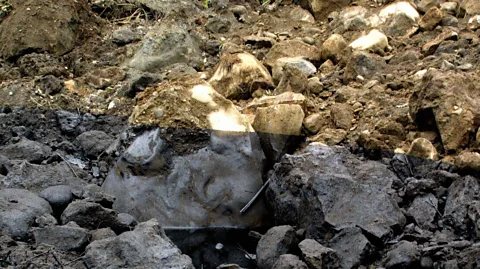 Getty Images
Getty ImagesFor decades, pits of waste crude oil have dotted the Amazon rainforest in northern Ecuador. Now people are using resilient plants, fungi and bacteria to try to clean them up.
Galo Rodriguez uses his machete to dig a hole near the small stream on his farm in the north-east of Ecuador, on the cusp of the Amazon rainforest. As he digs there is nothing unusual to be seen – but when he hits 32cm below the surface, the soil releases a distinct and pungent smell of gasoline.
More than half of his 35 hectares of land is primary forest, while the rest is sugar cane or small trees. But where he digs is devoid of trees or crops. It is covered only by grass. This area used to be smothered in oil after a nearby pipeline leaked. The oil filled his stream, killed of all of his fish and contaminated the only fresh water source he used for his cattle.
The oil sat here for 10 years before the company responsible for the pipeline came to clean it up, in 2016. Rodrigo says he watched as they collected some 12-15,000 cubic metres of oil off his property, but they didn’t remediate the soil. Today, in the stream just beside him, blue and green streaks of oil residue can still be seen in the water.
“For 10 or 11 years, this area didn’t produce anything. We abandoned it,” says the farmer. “Now we plan to plant guavas and chaya.”
You might also like:
Rodriguez is one of dozens of farmers in the north of Ecuador learning how to use plants to try to eliminate the oil contamination from his land. This process, known as bioremediation, uses living organisms like plants, fungi and microbes to break down pollutants, including crude oil.
There are several ways this could happen, but most of the hard work to break down crude oil happens below ground, where microorganisms are concentrated around the roots of plants and mineralise, or decompose, the crude components, making it easier for plants to take up. Some contaminants can be taken in by the plant directly and stored in its shoots and roots, or can be evaporated through the leaves.
The course Rodriguez attends is called “Guardians of the Soil”, which is an introduction to permaculture-based bioremediation for low-income communities, founded by local resident and independent researcher, Lexie Gropper.
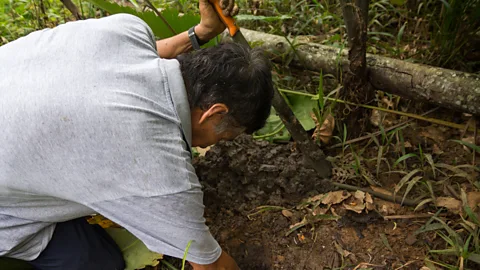 Kimberley Brown
Kimberley BrownGropper runs these workshops once a month, when she visits three communities in the Amazonian provinces of Sucumbíos and Orellana that have been some of the most affected by oil spills and petroleum dumping over the years. These communities are based in Shushufindi, Sacha and Lago Agrio, where she’s lived for six years.
Ecuador’s northern Amazon rainforest has seen heavy oil contamination since rich oil fields were discovered here in the 1960s. One source of contamination was by the oil company Texaco – later acquired by Chevron – which dumped billions of gallons of oil waste in the Amazon rainforest, most of which went into unlined, open-air pits in the ground. In 1993, thousands of community members filed a lawsuit against the company, saying it did not perform any adequate clean up and its drilling installations continued to contaminate the area, and demanded they pay for remediation. The oil company admitted to releasing the waste, but said it cleaned up its share of the contamination and was legally cleared of all future liabilities. Most recently, a court in the Hague found in favour of Chevron. This has turned into one of the most complex and longest-running environmental legal battles in history.
Environmentalists have referred to the oil contamination in the region as the Chernobyl of the Amazon. Locals say pipelines owned by other companies continue to leak and spill at least once a week. Some are cleared up rapidly, but others are left for prolonged periods. These unattended oil pits and spills have contaminated fresh water sources and have dire impacts on local aquatic life, ecosystems and human health, according to both locals and several studies in the region.
Gropper, who has lived in Lago Agrio for six years, began her pilot course in January to help local farmers and indigenous communities take small steps to confront these contaminants themselves.
“It’s been over 50 years, and there’s not a day that goes by that those pits aren’t impacting us,” says Gropper, “the point of this introductory course is to recognise a lot of things first off, recognise the need for this autonomy, and recognise the need for this communal strength and support, which is already happening.”
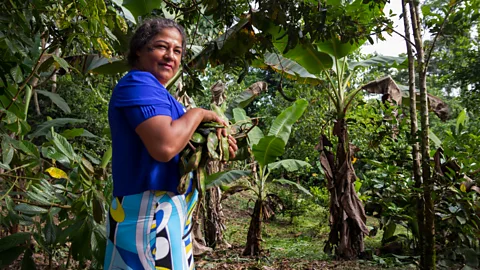 Kimberley Brown
Kimberley BrownThe focus on permaculture in her course was also deliberate, says Gropper, who says it’s much more than just focusing on agriculture diversity. She defines permaculture as a “mindset or a way of viewing the world”, which focuses on understanding and engaging with the local ecosystem and working in community.
At one workshop in Lago Agrio in February, the Chicago-based soil specialist and horticulture consultant Nance Klehm spoke with a group of some 50 community members, and showed them how to identify and engage with different types of soil. She asked participants to analyse various soil samples from contaminated sites, to coffee and banana plantations, and describe their colour, smell, texture and any kind of emotional or mental associations it brought up for them.
“I’m trying to have people re-engage with certain subtle complexities of nature,” says Klehm, adding that this will help people identify how a contaminant moves through the soil, and how fast. It’s the difference between clay, which will hold contaminants like a pool, or sand, which will allow it to drain right through, and everything in between.
For Klehm and Gropper, the next steps in remediation will involve laboratory testing of the acidity (pH) level in the soil. They then plan to develop a library of local plants that could be tried in the bioremediation process. The ultimate goal is to create an ecosystem of native plants and crops that can be farmed sustainably while also cleaning up the oil.
But bioremediation is not something that has been extensively tested or documented in the region, particularly using plants. Several studies have identified local microbes, bacteria and fungi as effective remediators in various settings. This included native bacteria (including species of Streptomyces and Bacillus) that were effective at breaking down bunker oil from a thermoelectric power plant in the southern city of Cuenca. Another study from the Amazon rainforest identified a native fungus (Geomyces) that could be used to remediate crude oil, using soil samples from the Lago Agrio oil field.
Laura Scalvenzi, a biotechnologist at Ecuador’s Amazon State University in Puyo and co-author of this study, says it’s surprising there isn’t more research into bioremediation in Ecuador. “It’s an oil-producing country,” she says. “This should be an area of science that’s a lot more developed.” The quantity of crude oil contamination in the rainforest is overwhelming, she adds, which makes studies here more complex, and funding from government or oil companies to do these studies is lacking.
Scalvenzi has been working with bioremediation in the country for five years, focusing on microbes and fungi in the Amazon. She and her colleagues begin trials by locating microorganisms in the contaminated soil itself and isolating those. If they live there naturally, it’s more probable they have the metabolism that allows them to degrade oil. Klehm and Gropper have been applying the same tactic to plants, saying those that continue to grow around the oil pits in the rainforest provide important clues.
“They’re either withstanding [the crude oil], or they’re actually using it as a food source. So if they use it as a food source, that means they're decomposing it into its basic elements to absorb it as nutrients,” says Gropper, meaning they’re already doing the heavy lifting.
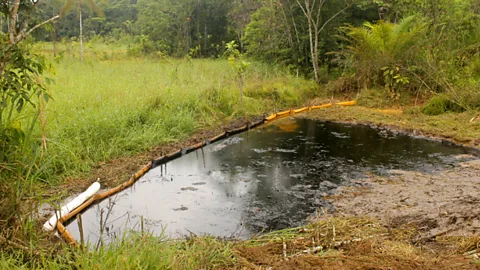 Donald Moncayo/UDAPT
Donald Moncayo/UDAPTBioremediation as a method to break down oil contamination is not new. Oil spills don’t often make the daily news, but spills happen on a regular basis worldwide. The US National Oceanic and Atmospheric Administration (NOAA) says there were 137 oil spills in the country in 2018, which amounts to about 11 per month. Canada’s National Energy Board says its pipelines spilled 7,945 tonnes (1,084 barrels) of oil on average per year between 2011 and 2014, while the European Space Agency estimates that 4.5 million tonnes of oil spill into the ocean every year.
Biologists and environmental engineers have long been working on alternative methods for clean-up, like bioremediation. Much has been written about the capacity of fungi to break down petroleum contaminants and absorb heavy metals. Studies across Canada have found willow trees to be effective at breaking down organic oil contaminants. Other studies have found poplar trees, with their long roots, to be effective in remediating and filtering contaminated groundwater, while sunflowers have been found to absorb everything from lead to cadmium and zinc, in controlled environments.
But biologists and environmental engineers agree that it’s misleading to say that any one kind of plant works best for bioremediating soils after oil spills. The plant’s effectiveness always depends on a variety of factors, such as local climate, type of soil, type of oil contamination, how long the contamination has been there, and how much is present.
In either case, it’s essential to work with local plants, says Nelson Marmiroli, professor of environmental biotechnology at the University of Parma in Italy. Introducing a foreign species runs the risk that it becomes a nuisance itself as an invasive species, or it could simply be unable to adapt to the local environment and die.
Marmiroli has been studying and working with bioremediation for 40 years, and says it has “proved effective in various instances for both contaminations in soil and water”. At one former crude oil refinery site near Naples, where he had been tasked with cleaning up after spills, Marmiroli describes the process of excavating tonnes of contaminated soil and placing it into large piles under a tarpaulin, where it could be protected from unexpected weather patterns.
Here they injected it with extra microorganisms, like native bacteria found in the same soil, to help break down the contaminants faster and more effectively. These soil plots were continuously turned over to let in air and oxidise the soil, and were closely monitored throughout the bioremediation process, before they were put back in place at the refinery. Another method, says Marmiroli, would have been to apply fertiliser to the contaminated site that would feed the microorganisms already present in the soil.
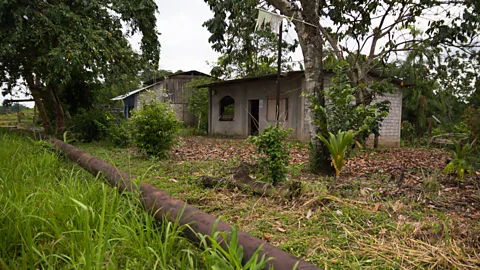 Kimberley Brown
Kimberley BrownPretty much all bioremediation works by “microbial consortium”, says Steve Rock, environmental engineer at the Environmental Protection Agency’s National Risk Management Research Laboratory in the US. Everything from fungi and macroinvertebrates (like worms) to plants often work better together than by themselves, he added.
“So the art of phyto- and bioremediation is figuring out which pieces are missing and adding that,” says Rock. At the well-known Exxon Valdez oil spill off the coast of Alaska in 1989, for example, the company struggled to clean it up until scientists realised a missing nutrient in the surrounding environment was nitrogen. When they added fertiliser containing nitrogen, “the oil degraded fairly naturally”, adds Rock.
Of course, like any clean-up method for heavy pollutants, bioremediation has its limitations. The sites often require a lot of space for the plants to grow, which is harder for oil leaks in towns, cities or anywhere close to buildings, highways and railroad tracks. It also requires a lot of time for nature to do its work, which is not ideal for areas that require a fast clean.
Marmiroli says bioremediation is still “much more friendly and environmentally sustainable” compared with industrial clean-up methods. The most effective industrial method is soil washing, he says, which involves collecting the contaminated soil, putting it into a large machine that uses a variety of chemicals to extract the contaminant, then putting the soil back into place. Not only is this method very expensive, he says, but the cleaning chemicals also degrade the nutrients and microorganisms in the soil, and leaves you with the problem of having to dispose of the extracted contaminant.
To speed up or improve bioremediation, Marmiroli says he prefers to experiment with other natural methods like fertilisers or biochar, “because this is accessible to anybody,” he says. “It’s sustainable technology.”
 Getty Images
Getty ImagesLarge-scale bioremediation methods have also been applied in Ecuador. Miguel Angel Gualoto, professor of environmental engineering at the Universidad de las Americas in Quito, helped design and oversee several bioremediation initiatives in the north-eastern Amazon.
One project for Ecuador’s Ministry of Environment involved cleaning an oil spill that had occurred in the 1980s. Nearly 30 years later the project began with excavating the contaminated soil and moved it to a nearby area where it could be oxidised and treated, much like Marmiroli’s work. Here they infused it with the naturally occurring fungi and bacteria found in the nearby soil, as well as compost, before putting it back in place.
It was a large and painstaking process – a team of 13 people worked for 11 months in the harsh conditions of the rainforest to clear up just one pool of oil. In total, the project cost over $2m (£1.5m).
Before the job was done, Gualoto says his team found almost 80 other oil pits and spills, most of them buried by a thin layer of vegetation. They never returned to address these sites, saying no one is interested in funding bioremediation as industrial soil washing is more lucrative. Plants and microbes in contrast don’t generate a profit for anyone and therefore “aren’t well looked upon”, he says.
Gualoto says projects like Gropper’s permaculture initiative will work to remediate contaminated soils, if and when the oil pits can be eradicated. “If you put a plant on a pool of oil, nothing will happen,” he says.
Gropper acknowledges the limitations of permaculture against these oil pits, and says much more is needed to get to the root of the problem. “We shouldn't be in this situation, that we have to remediate our own lands,” says Gropper. But, through her permaculture project, she aims “to identify what it is that we can do on the level of the family and the community”.
Indeed, the reasons local people are turning to permaculture are many and varied. Elsa Maria Rios Jumbo, another participant of permaculture course, says she began the practice because she believed it would give her more control over her own health. Rios, who survived leukemia a few years ago, grows 12 kinds of medicinal plants, eight types of orchids, 38 kinds of fruit, and has a small vegetable garden on a one-hectare piece of land with her husband.
But Rios is also aware that both neighbours on either side of her have oil pits in their yards. She wonders whether the pools overflow during heavy rains or seep through the soil. She believes learning about permaculture and bioremediation will help her better prepare for these threats, she says. “We’re going to put in practice what we’ve been learning, and that’s good for me, my family and my whole community,” says Rios amid the beaming guava trees in her backyard. “We have to start somewhere.”
--
The emissions from travel it took to report this story were 77kg CO2, travelling by bus and taxi. The digital emissions from this story are an estimated 1.2g to 3.6g CO2 per page view. Find out more about how we calculated this figure here.
--
If you liked this story, sign up for the weekly bbc.com features newsletter, called “The Essential List”. A handpicked selection of stories from BBC Future, Culture, Worklife, and Travel, delivered to your inbox every Friday.
